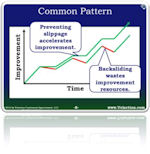Boredom
Boredom, not surprisingly, is simply tedium or a lack of excitement in your job. Boredom (or lack thereof) plays a big role in job satisfaction. Nobody wants to go to work and face eight or ten dull, monotonous hours every day. What a lot of people fail to recognize is that there is significant waste associated with boredom at work. Bored employees may get the job done, but they are not as effective and productive Read more…



